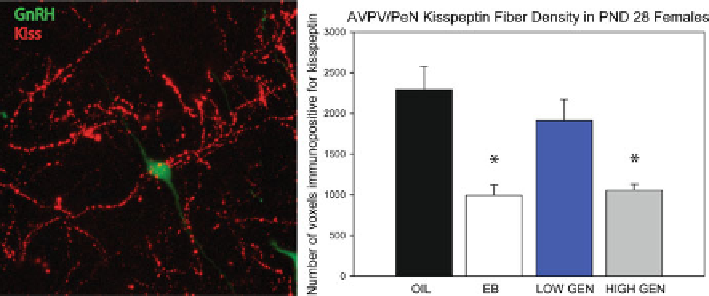Biology Reference
In-Depth Information
Fig. 21.4
Neonatal exposure to GEN reduces the density of AVPV/PeN fi bers immunoreactive for
kisspeptin at puberty (PND 28) in female rats. Depicted is a single GnRH neuron (
green
) sur-
rounded by and receiving efferent projections from kisspeptin neurons (
red
). This plexus is signifi -
cantly denser in females than males, a sex difference which becomes more robust across the
pubertal transition. Neonatal exposure to a high (10 mg/kg) but not a low (1 mg/kg) dose of the
isofl avone phytoestrogen GEN advances vaginal opening. Early female puberty is accompanied by
a marked and signifi cant reduction in the density of kisspeptin fi bers in the AVPV/PeN that is
recapitulated by estradiol benzoate (EB) exposure and suggestive of masculinization
[
129
], it remains to be defi nitively established. Finally, there is the possibility that
disruption of other RFamides, such as gonadotropin-inhibiting hormone (GnIH and
the human homologs RFRP-1 and RFRP-3 [
130
]), may also contribute to the
steady advancement of female puberty. Data testing this hypothesis is only just
beginning to emerge [
128
].
Future Directions
There is clear and compounding evidence that kisspeptin signaling pathways are
vulnerable to endocrine disruption, particularly when exposure occurs in develop-
ment. By extension, work in this area has also revealed how sensitive this system is
to endogenous hormones and the long-term consequences of perturbation by hor-
mone administration in early life. Thus, the endocrine disruption fi eld contributes
translational but also fundamental knowledge about the steroid hormone-dependent
organization and function of the kisspeptin system across the life span, making it a
truly interdisciplinary area of study. As this research progresses, it will advance
understanding of the mechanisms by which EDCs act to confer disease, and also
how hormones shape the sex-specifi c development of the kisspeptin system across
the life span. Importantly, it will provide insights into the critical developmental
windows during which kisspeptin neurons are sensitive to gonadal hormones and
the compounds that mimic them, and also the mechanisms by which sex differences
in the kisspeptin system emerge.

Search WWH ::

Custom Search